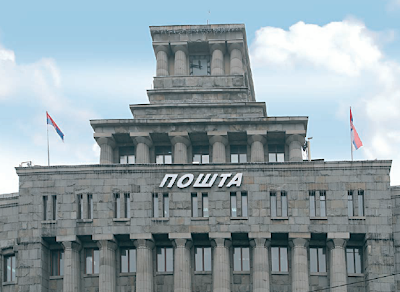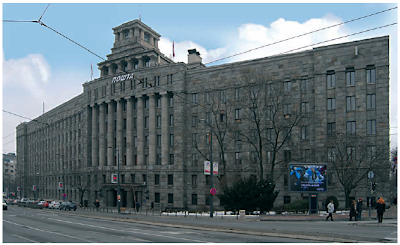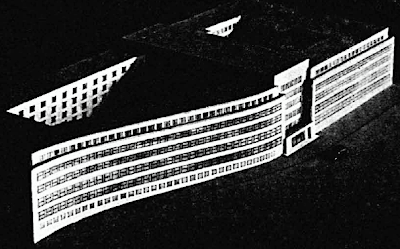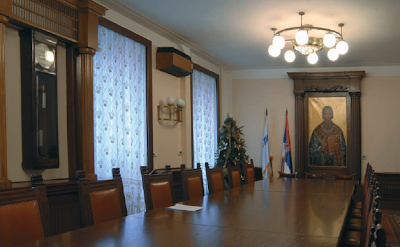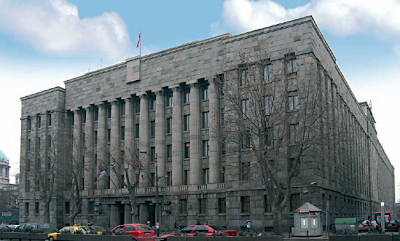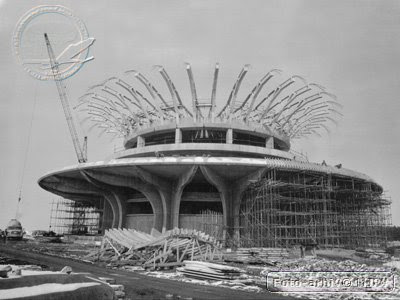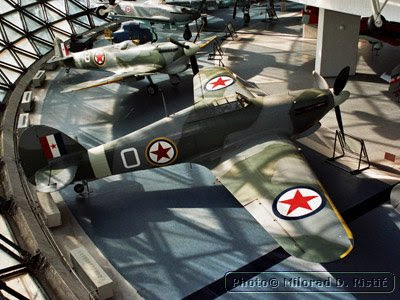
Villa of Stevka Milicevic, Uzicka 54, Belgrade (1929-1930)
Petar and Branko Krstic, the architects that made the St.Mark's Church in Belgrade (here the post) were mostly popular for realizing in the 1920's and 1930's some masterpieces of modernism in Belgrade.
The modernism in Belgrade was not just the same as the modernism in the rest of Europe..it always kept a certain Serbian flavor, making it uniqie of its kind. Following some modernist rules, Serbian architects like the Krstic brothers preserved also the historical or national style. For that their project showed both: modern shapes and language and traditional elements of the burgeoise architecture.
So it made the buildings much more approchable for the "normal" upper-class citizen and were not like for example Le Corbusier's villas in France, that were projects more for an intellectual elite.
Ljiljana Blagojevic calls the Krstic brother's architecture "Hybrid Architecture. ( in her book "The elusive margins of Belgrade architecture" ).
A good example is the villa of barrister Milicevic (1929-1930). It can be seen as the hybrid form of the transitional stage in the definition of the modern style.
From the Blagojevic's book: The form of the villa is a simple cube set into the sloping terrain, appearing from the street as a single-story house with a raised ground floor and opening toward the garden with a full height of two levels.
The duality is accentuated by the facade decoration in bold horizontal striping of the piano nobile, the quite elaborate design of the approaching footbridge and external stairs, and the front garden layout. The porch over the main entrance is supported by caryatids, set in front of the asymmetrical facade as a direct historicist quotation.
The villa reflected the architects' aim of a harmonious synthesis of art, decoration, and architecture, which was to become a trademark of their particular style.

In their design of Villa Vukosava (1930-1931) for Professor Dusan Tomic, the hybrid is created by crossing the traditional structural system and plan with an externally modernized form.
The compact plan, constricted by the massive load-bearing wall structure, is organized around a central hall in a traditional manner, with no exploration of the continuity of space between the ground and first floor. The staircase is literally built in between the thick brickwork walls, and the private quarters on the upper level simply repeat the arrangement of rooms from below.
The formal interpretation, however, moves away from historicist paradigms: the cubic composition is simple and restrained, and the facades are plain and smooth. The cubic purity, however, had to be given the proper dress: clear style signifiers such as the elaborate, decorative moldings signifying modern style planted onto the wall surface.
The final touch of luxury to the otherwise modest villa was provided by the articulation of the entrance zone with generously curved portal and wide external stairs, originally envisaged with an asymmetrically positioned sculpture by Branko Krstic, a draped nude leading two mythical dogs, and a shallow rectangular pond in front.


Lazic Villa at Milovana Glisica Street 4, Belgrade (1931)
With the double villa of Olga Lazic (1931), the Krstic brothers achieved the high point of their modernist career. The atypical site of the villa, with a very limited depth and stretching longitudinally parallel to the street, was sold by the neighboring owner on condition that only one house be built on it.
The architects were, however, requested by their client to design two independent houses, which they did by resolving the riddle in a clever, rather ambiguous manner. They designed two identical, totally separated houses mirrored in corner positions of the site, yet positively connected by an elongated, one-story-high gazebo, thus achieving the effective appearance of one integral structure.
The effect was enhanced by the planar treatment of the facade cladding in sleek marble slabs laid in a continual pattern, in which subtle variation of the grid emphasized the longitudinal stretch of the composition.
If anything, the brothers Krstic were masters of finishes. Even today, after decades of neglect, their buildings have to be appreciated for the finesse and quality of detailing in the use of materials. The facade of the rental apartment building of Mrs. Jelinic in Kumanovska Street (1930-1931) is perhaps the most telling example of their skill.
It is no wonder that they themselves chose this building to represent them on the pages of the magazine Arhitektura. The facade surface is formed by the inlaid materials of dark polished granite, matte gray-green stone, Terranova plastering, and Branko Krstic's cast reliefs in reconstituted stone, which are all carefully fitted together as a piece of marquetry.
It is this skill in putting together different textures, patterns, and materials that distinguishes the Krstic label, however much the designs, or even styles, of their facades varied from case to case.
Some examples of Krstic brothers facades:
In this sense, a Krstic facade is easily recognized, whether it is the starkly elegant column dress cut like the Igumanov Palace (1936-1937); or the simple little all-purpose black dress like the rental apartment building for Josif Sojat in Brankova Street (1934).
And if the sartorial metaphor is cast aside, the Krstic brothers still hold prominence as one of the most representative creators of the Belgrade modern style.

 Elegant column at the Igumanov Palace, Terazije, Belgarde (1936-1937)
Elegant column at the Igumanov Palace, Terazije, Belgarde (1936-1937)
Simple but very tide facade for the rental apartment building for Josif Sojat in Brankova Street, Belgarde (1934)

The Yugoslavian Pavillon at the World Trade Fair in Philadelphia (1924-1925)
Other buildings by Petar and Branko Krstic in this blog:
Agrarian bank building in Belgrade
St. Mark's Church in Belgrade
















